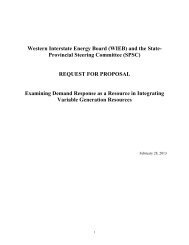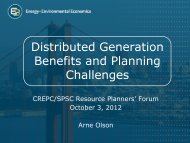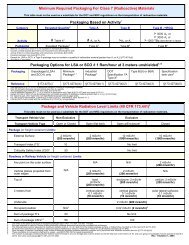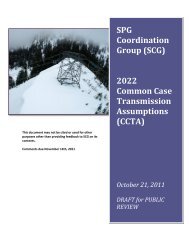North American Natural Gas Midstream Infrastructure Through 2035 ...
North American Natural Gas Midstream Infrastructure Through 2035 ...
North American Natural Gas Midstream Infrastructure Through 2035 ...
Create successful ePaper yourself
Turn your PDF publications into a flip-book with our unique Google optimized e-Paper software.
Oil Production Growth and Associated Pipeline <strong>Infrastructure</strong><br />
U.S. and Canadian oil production is projected to increase by<br />
1.7 percent per year from 8.3 million barrels in 2010 to<br />
12.7 million barrels in <strong>2035</strong>. The largest areas of production<br />
growth include Western Canada and the U.S. <strong>North</strong>eastern<br />
Rocky Mountains. Nearly all of Canada’s oil production<br />
growth comes from increases of bitumen and synthetic<br />
crude production from oil sands that will account for over<br />
85 percent of Western Canada’s oil production in <strong>2035</strong><br />
(compared with 65 percent in 2010). The U.S. <strong>North</strong>eastern<br />
Rocky Mountains contain several areas where oil<br />
production is projected to grow significantly. These include<br />
the Bakken and Three Forks shale formations in <strong>North</strong><br />
Dakota and Montana (Central region), and the Niobrara<br />
shale formation in the Denver, Powder River and the Green<br />
River basins of Wyoming and Colorado (Central region).<br />
To support the balance of oil supply and demand, an additional five million barrels per day of midstream<br />
pipeline capacity is needed to transport increasing oil production over the next 25 years. Expansion of<br />
the existing oil pipeline grid could add 19,000 miles of oil pipeline (an average of 800 miles per year) at a<br />
capital cost of $1.3 billion per year over the next 25 years or $31.4 billion (2010$) total. A significant<br />
amount of this infrastructure will be built in Canada and in the U.S. Central and Midwest region to<br />
transport Canadian bitumen synthetic crude to U.S. refineries.<br />
Conclusions<br />
This analysis highlights the need for and importance of new midstream natural gas infrastructure into<br />
the foreseeable future. U.S. and Canadian natural gas markets are expected to grow mostly because of<br />
increased gas use in power generation. <strong>Natural</strong> gas production is likely to increase with shale gas<br />
remaining a prolific source of new gas supply. New midstream infrastructure will be needed to gather,<br />
process, and transport growing natural gas supplies to end‐users.<br />
NGL and oil production likely will increase significantly as well. This is important, because the ability to<br />
process and deliver NGLs is critical to developing natural gas resources fully and because there will be<br />
some production of associated natural gas in connection with renewed domestic oil production. In the<br />
ICF projection, U.S. and Canadian NGL and oil production grow by about 70 percent and 50 percent,<br />
respectively, over the next 25 years. This growth will create additional need for infrastructure over<br />
time.<br />
12

















